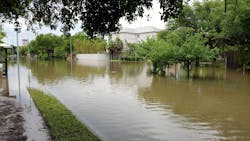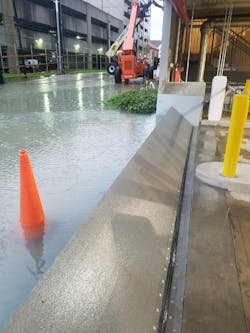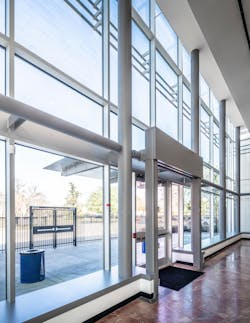Across the United States, many areas are experiencing more extreme weather. This includes higher highs and lower lows in regard to temperature and precipitation — as well as a greater frequency of severe weather events such as rainstorms, hurricanes, tornadoes, and floods.
The result has been an increase in weather-related damage to commercial and residential properties — however, a property can mitigate these damages with a solid flood protection system.
Historically, flooding is one of the costliest natural disasters in the U.S. on an annual basis. The National Oceanic and Atmospheric Administration (NOAA) periodically updates estimates of local rainfall intensity, which can impact how communities calculate their local 100- or 500-year storm event(s). These storm events are used to model and map the new 100- and 500-year floodplains that the Federal Emergency Management Agency (FEMA) approves.
Flood Insurance Rate Maps (FIRMs) attempt to address area-wide flood risks retroactively and may not reflect the increased rainfall intensities and localized street flooding that now occur more frequently.
For example, Houston, Texas, experienced three consecutive years of 100-year storm events starting in 2015. These were the Memorial Day flood in 2015, the Tax Day flood in 2016, and flooding associated with Hurricane Harvey in 2017. The impacts of these three different storms were significant: the first two produced localized flooding while the third was regional in nature and set a new national rainfall record.
The impact of severe weather can be significant in one region of a city and not affect another part. This is due to how localized some storms may be. Localized flooding typically has less to do with the rising of floodplain floodwaters and, instead, is due to inlets not being able to handle the demand of incoming stormwater. In some cases, grading can accomplish stormwater improvements to ensure that water is able to continue to move downstream — rather than becoming trapped because it can no longer flow downstream with gravity.
Appreciating Flood Protection
For example, an office tower and detached parking garage in Houston experienced this exact scenario several times. After the Houston Memorial Day storm in 2015, a tenant was unable to return to the building for weeks. It was such a disruption that the tenant offered the building owner $250,000 to help pay for the flood protection improvements if they were completed by the beginning of the next hurricane season.
The newly installed flood protection system in the Houston building was put to the test as two more back-to-back major storms happened in the following years. With further flooding and obstruction prevented, the building owner was able to understand the value of flood protection improvements.
Flood Protection Design
The ability of a property to absorb flood or stormwater damages can play a significant part in determining how to approach flood mitigation. When designing a flood protection system, a key question is whether the cost of recovery is less than the cost of investment to protect against a potential flood.
These costs are not only that of installing a flood protection system but also the cost of maintenance, any inconvenience related to the system, and the ability to implement the system when needed. In each case, these costs need to be identified and made available to the designer, allowing them to make an informed decision about the cost of that risk.
Effective flood protection requires an understanding of both the broad and localized watershed issues and associated risks that impact a property, as well as an understanding of the community-wide protection systems related to a specific property.
Even the best flood protection design will be useless if not properly deployed — and even a well-deployed system can negate the investment on protection if it does not consider all the points of exposure. If the flood barrier is a series of interlocking horizontal barriers that are not properly interlocked, water can pass under the lowest flood barrier, eliminating the function of the entire system.
Flood Protection Approaches
Building owners and operators should consider two major approaches in designing a flood protection system: both wet and dry flood protection.
In a wet flood proofing system, the structure and contents are designed to get wet by floodwaters. The architect and engineers design the structure with intent to flood and, after a brief cleanup, return to normal operations. All materials used for the construction of the structure should be water resistant. More important, the electrical and mechanical systems must be isolated and protected from floodwaters.
In contrast, dry floodproofing is accomplished by either making the structure watertight below its design flood protection elevation or by building an exterior protective barrier and accommodating rainfall that falls behind the barrier. Additionally, dry flood protection can be broken down into active versus passive methods.
Assessing a Structure
An assessment of the structure should determine the appropriate level of flood protection required. This helps decide which flood mitigations are practical or feasible. Conducting an assessment requires data and information from the owner, FEMA, and the surrounding municipality/authority.
At this point, the building owner’s risk tolerance needs exploring: what height is high enough for flood protection? Local code requirements and site history are obviously important, but the owner’s budget, schedule, and insurance profile can also influence the desired flood protection elevation.
System Documentation
The end of construction on a building is just the beginning of the lifespan for a flood protection system. Proper documentation is just as crucial when it comes to implementing the flood protection program.
The design team should work with the owner's staff to develop documentation addressing maintenance, testing, and operations for the system. This documentation serves as a guide to train future staff — and it can be a critical reference before and during a storm event. The owner’s staff should also maintain the system, and train to operate it, on a semi-annual to quarterly basis.
Property owners can’t know when the next severe storm will hit — only that it will hit. When it comes to one of the costliest natural disasters in the U.S., the best defense is a solid flood protection program that is properly implemented.
Published in Stormwater magazine, November 2022.









